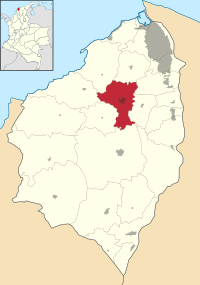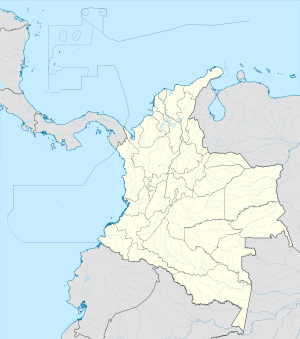Baranoa facts for kids
Quick facts for kids
Baranoa
|
||
|---|---|---|
|
||

Location of the city of Baranoa in the Department of Atlántico.
|
||
| Country | ||
| Region | Caribbean | |
| Department | Atlántico | |
| Founded | 1543 | |
| Area | ||
| • Municipality | 121.3 km2 (46.8 sq mi) | |
| • Urban | 5.22 km2 (2.02 sq mi) | |
| Elevation | 118 m (387 ft) | |
| Population
(2018 census)
|
||
| • Municipality | 68,383 | |
| • Density | 563.75/km2 (1,460.1/sq mi) | |
| • Urban | 51,730 | |
| • Urban density | 9,910/km2 (25,667/sq mi) | |
| Demonym(s) | Baranoero | |
| Time zone | UTC-5 | |
| Area code(s) | 57 + 5 | |
| Website | Official website: http://www.baranoa-atlantico.gov.co | |
Baranoa is a lively city and a municipality in the Atlántico department of Colombia. It is famous for being the birthplace of Juan José Nieto Gil. He was the first documented Black president of Colombia. Baranoa is located almost exactly in the center of the Atlántico department. Because of its central spot, it is often called "El corazón alegre del Atlántico," which means "The happy heart of the Atlantic."
Contents
Exploring Baranoa's Geography
Baranoa covers an area of about 121.3 square kilometers (46.8 square miles). This area includes different types of land. You can find rural areas, city areas, and even protected natural spaces.
Waterways of Baranoa
Several small rivers, called creeks, flow through Baranoa. These include Santa Rosa, Campeche, Big Creek, and Deep Creek. They help keep the land fertile and green.
Who Lives in Baranoa?
According to a 2018 count, Baranoa has a population of 62,382 people. Most of these people, about 82.63%, live in the city part of Baranoa. The remaining 17.37% live in the countryside.
A Look at Baranoa's History
Baranoa was originally a settlement for indigenous people. It was located near a waterway called Big Creek.
Spanish Arrival and Early Days
In 1534, Spanish explorers arrived in the area. Don Pedro de Heredia led the Spanish conquest. In October 1543, the Spanish Crown gave control of Baranoa to Hernando Dávila. Over the years, other people like Inés de Mendoza and Hernando De la Salas also managed the area.
Becoming a Municipality
Between 1744 and 1745, Viceroy Sebastian de Eslava ordered changes to the town. As a result, 39 Spanish families moved there. They helped create the Parish of Santa Ana of Baranoa. On October 23, 1856, Baranoa officially became a municipality. This decision was based on its population size and how much it had grown. Its status and borders were confirmed again on December 16, 1964.
Baranoa's Economy
The people of Baranoa focus on several important economic activities.
Farming and Ranching
Many residents work in farming and raising animals. They raise cattle and grow crops like corn, cassava (a root vegetable), and cotton. They also grow Jocote plums.
Plum Festival
The Jocote plum is so important that a special Plum Festival takes place in northern Colombia. This festival celebrates the harvest of these delicious fruits.
Mining Activities
Baranoa also has natural resources. Minerals like calcite and iron are mined in the area.
See also



